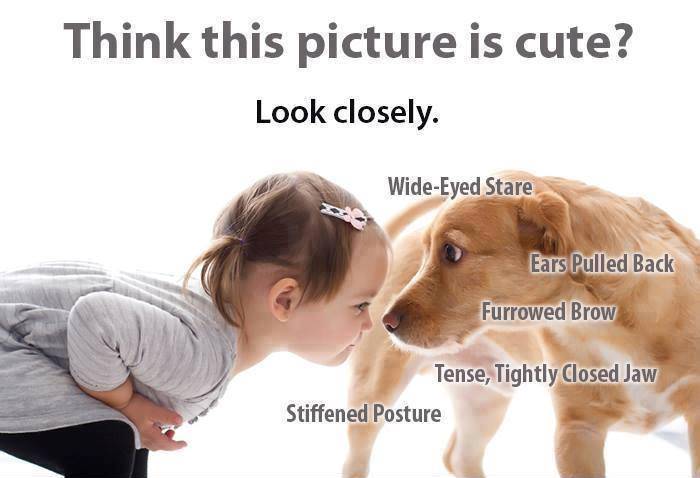menu
Kids and Dogs
Children, Dogs, and Safety
It’s hard to believe that 77% of dog bites come from a family or friend’s dog. That means that these aren’t crazy, stray, vicious dogs - they are OUR pet dogs! Please watch the video and look at this at this page Are Your Kids and Dogs Safe? Together, we can stop the 77. More on Dogs and Children: How to Keep Them Both Safe
Whether or not you have a dog of your own, teaching children how to treat animals is very important. Equally important is teaching your child about basic dog behavior. This training is vital for your child’s safety, but also dogs’ safety. We don't know about you, but some of the photos of dogs and children we see on social media make us cringe and feel uncomfortable, even while others find them cute
People believe that a good dog should be tolerant of any behavior from children, however this is as far from the truth as you can get. Surprising to many people is to learn that a large percentage of dog bites occur because humans, especially children, treat the animal inappropriately, ignore the dog’s signals and efforts to make the behavior stop, and push the dog until it feels it has no other option to make the treatment stop other than biting the human.
Avoiding tragic situations in which children can be injured and dogs are unnecessarily euthanized is not difficult; it involves common sense and educating your children about how to behave around their furry companions.
Teach Children of every age to respect dogs. As a parent, it is your job to keep your children and your dog safe. Be responsible. Teach and follow boundaries with kids and pets. Even the most well-behaved dogs can breach a tolerance level. Don’t allow your child to test your dog’s good nature. Many euthanasia's happen due to a parent's negligence in creating good boundaries and teaching their child. Stand up for your dog and help your children learn right from wrong when it comes to animals.



A picture showing classic calming signals that a dog gives when he is NOT comfortable. Please note all four signs in these pictures indicating that the dog is NOT enjoying this situation:
- Licking the lips
- Showing the whites of his eyes
- Panting when not overheated
- Turning his head away
Do NOT Allow Children to:
DISTURB A DOG:
- When they are eating
- When they are sleeping
- Or in their crate or safe space
- Get into crates with dogs (a crate is a dog's special place and meant for no one else)
- Chase a dog that is walking away
- Get in a dogs personal space
- Put their face near a dogs face
- Do not take food, toys, or treats from dogs
- Pull ears or tail
- Stand on
- Sit on
- Ride on
- Wrestle with
- Smacking
- Hugging
- Kissing
- Hovering over
- Poking
- Teasing
- Pestering
STRESS
Humans face stress and so do dogs. However, while people are able to express them-selves, dogs communicate using subtle signs of body language. At times inappropriate human behavior causes stress for dogs. Know the signals.
Supervision is Number ONE
The most important rule to follow when you have a child and a dog is to supervise interactions. Never leave a child alone with a dog, no matter how much you trust either of them. Learn to read your dog’s behavior. Remind your child of the rules of respect when dealing with their dog. As a result, they’ll have a rich, loving bond that will last them a lifetime, and they will have learned the essentials of being a dog owner later in life.
The most important rule to follow when you have a child and a dog is to supervise interactions. Never leave a child alone with a dog, no matter how much you trust either of them. Learn to read your dog’s behavior. Remind your child of the rules of respect when dealing with their dog. As a result, they’ll have a rich, loving bond that will last them a lifetime, and they will have learned the essentials of being a dog owner later in life.
A Dog's Safe Space
Dogs have boundaries, just like humans. The best way to explain this to children is to remind them that they shouldn't do it to others if they wouldn’t like it done to them. There should be a quiet place where dogs can go to be alone. Crates work well, but it can be a small undisturbed quiet area of the house with a dog bed where they can retreat. Teach children that this space is sacred and reserved for the dog only. They should never enter this safe space and should especially never try to wake their dog if he is sleeping.
Hugging and Kissing
Family members frequently hug and kiss children, and children might transfer this behavior to a dog. This can be associated as a threat, because, it is not normal canine behavior. People should teach their children to touch dogs appropriately. Over time, sometimes people can get their dogs used to hugs, but it is not a natural behavior for canines. Appropriate touching means they should never hug or kiss their dog’s face or head. They should never approach their face to their dog’s face and should treat their pet with the uttermost respect. Instead, show your child that it is alright to pet the dog on its back and at the base of the tail. It is also appropriate to scratch them behind the ears or on the neck if they like it and, on the belly, if they roll over for you.
Playing
Children should know a few basic guidelines for playing with a dog safely. Riding or climbing on dogs, not matter how big they are should never happen. This behavior is bad for the dog’s back but can also be very overwhelming for the dog, not respecting a dog’s personal space. Similarly, allowing games of wrestling can get the dog over excited and out of hand. Teach children never to take a toy, chew bone or food, etc., from a dog’s mouth. The dog may not be in the mood to share and could guard his toy aggressively. Avoid playing tug of war as this is another game that dogs become excited and may be too much for children.
Teach children to contain their excitement when playing with their pets. Dogs have sensitive hearing and can get easily irritated with children running around and screaming. Saying this doesn’t mean children can’t play with their dogs. Children should be respectfully quiet and gentle during play sessions; children can engage in various games with their dogs. The best games to play are hide and seek, scenting games, and trick training (for older children). Fetch is also a great game to play if your dog knows how to “drop it,” this way, there is no physical contact between the child and the dog.
Caring for the Dog
Involving children in dogs care is a good idea as it can teach them about dog behavior and responsibility for animals. It will also help your dog and child bond.
Interacting with Strange Dogs
Teach children to not to run towards or even approach dogs they don’t know and certainly never to pet them unless the owner has granted them permission to do so.

